
Coast Guard Air Station Port Angeles was commissioned on 1 June 1935. It is located on Ediz Hook, a level sand spit extending from the mainland north and east into the Straits of Juan de Fuca. The location, originally chosen for its strategic defense location, became the first Coast Guard Air station on the Pacific Coast. The first aircraft, a Douglas RD-4 Dolphin amphibian, arrived on 11 June. The air station also had two 75 foot patrol boats assigned. Established to aid in law enforcement and anti smuggling operations, the station almost immediately became involved in what is today its primary mission: protection of life and property at sea.
At the outbreak of World War II, the Air Station had on board a JF-2 Duck, a JRF Goose and a J4F Widgeon. These numbers would increase in 1942 and were supplemented by Curtiss SO3C-1s in the landplane configuration. Port Angeles was given an anti-submarine mission. They patrolled the Straights and off shore areas, escorted convoys and set up detachments at Neah Bay, Washington, Quillayute, Washington, Astoria, Oregon, and North Bend, Oregon. During this period a short runway was added to train Navy pilots for carrier landings and the air station expanded to include a gunnery training school.
In September of 1944 the unit officially became Coast Guard Group Port Angeles and was the headquarters of the Air Rescue System for the Northwest Sea Frontier. The Air Station was also home of the only Coast Guard Land Rescue Team which proved instrumental in saving lives of many naval pilots who crashed in the mountainous area during the massive training effort during the war.
The first helicopter, a HO3S-1G arrived in 1946. This was replaced by HO4Ss in 1951. The last fixed-wing aircraft to operate from the Port Angeles Air Station was the HU-16E Albatross which left in 1973. Since that time the Air Station has been an all helicopter unit. The HH-52A Seaguard arrived in 1965.
Air Station Port Angeles received the upgraded HH-65C in July 2007 providing a significant improvement in aircraft capability. The HH-65C was replaced by the MH-65C in 2008. The MH-65C, in addition to an upgraded electronics suite, provides hardware required to mount weapons for the Coast Guard’s Airborne Use of Force (AUF) mission. The Air Station completed the AUF transition in November 2008.
In addition to rescue at sea, CGAS Port Angeles’ proximity to the Olympic Mountains not only diversifies the flight environment, but brought about several unique SAR cases. Of note were the rescues, after extensive planning, of injured mountain climbers hoisted off of Brothers Mountain near Bremerton Washington. The first case occurred in July 2006 at an altitude of 6300 feet MSL. The second case hoisted a 62 year old hiker from the summit at 6900 feet MSL in May 2007. This was not only the highest altitude helicopter of record in the Olympic Mountains, but also the highest HH-65 rescue to date.
During a typical year, Group Port Angeles units carry out over 400 search and rescue missions, saving 35 lives and assisting over 500 persons. This does not reflect special missions such as the response to devastating flooding that occurred in southern Washington in December 2007 when a winter storm struck the inland communities of Chehalis and Centralia. Many residents became trapped in their homes and required extraction by helicopter. A unified response by Air Stations Port Angeles and Astoria saw the rescue of over 300 persons in less than 48 hours. A Coast Guard Meritorious Unit Commendation was awarded.
